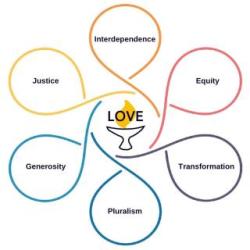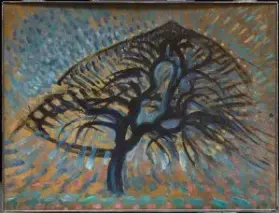 Even though I’ve never considered myself a poet, I recently decided to take a class on writing poetry. My eyes were opened to a world of writing that wasn’t about rhyming or alliteration, but more about connecting to both the inner and outer worlds. Poetry has long been revered for its ability to nourish the soul and promote healing on many levels. This was new to me. From providing cathartic release to cultivating mindfulness, deepening our connection with nature, facilitating self-discovery, and opening gateways to the sacred, the reading and writing of poetry offer many therapeutic benefits. This article will explore the various healing dimensions of poetry.
Even though I’ve never considered myself a poet, I recently decided to take a class on writing poetry. My eyes were opened to a world of writing that wasn’t about rhyming or alliteration, but more about connecting to both the inner and outer worlds. Poetry has long been revered for its ability to nourish the soul and promote healing on many levels. This was new to me. From providing cathartic release to cultivating mindfulness, deepening our connection with nature, facilitating self-discovery, and opening gateways to the sacred, the reading and writing of poetry offer many therapeutic benefits. This article will explore the various healing dimensions of poetry.
Poetry Can Help Process Difficult Emotions
The act of writing poetry can serve as a powerful cathartic release, allowing people to express and process difficult emotions constructively. Poetry provides a creative outlet to explore pain, trauma, grief, and other complex feelings that may be too overwhelming to confront directly.
Reading poetry can also have a cathartic effect by giving voice to experiences the reader may be struggling with. Finding the words to reflect our inner turmoil can provide a profoundly validating and therapeutic experience. As the poet Audre Lorde famously said, “Poetry is not a luxury. It is a vital necessity of our existence.”
Studies have shown benefits from poetry therapy groups where participants are encouraged to write and share their work in a supportive environment. A study published in the Journal of Poetry Therapy found that after just eight sessions, poetry therapy group members reported significantly reduced levels of distress along with an increased ability to perceive and express their feelings adaptively.
From the ancient wisdom of philosophers and mystics to modern psychotherapy practices, poetry has long been recognized as a powerful tool for gaining self-awareness, processing emotions, and promoting psychological healing. By engaging both mind and heart, the creative process tapped by poetry can be a transformative force.
Exercise: Poetry can be as effective as journaling at processing difficult emotions. It may even be more effective because you are not as engaged with completing sentences, but with getting ideas and thoughts out on the page. Try putting together phrases that describe your thoughts without worrying about whether they make complete sentences or not. (see poetry writing guide below.)
Poetry As A Mindfulness Practice
The reading and writing of poetry requires a present-focused attention that mirrors the practice of mindfulness. As the poet Mary Oliver said, “Poetry is one of the ancient arts of mindfulness.”
The crafting of poetry demands that poets deeply observe the world around them and their inner landscape with caring presence. This “being mode” of attentiveness to sights, sounds, thoughts, and feelings cultivates the skills of mindfulness (Hutt, 1996).
Research shows poetry can enhance mindful awareness and acceptance. A study published in the Journal of Poetry Therapy found that hospital patients who did poetry exercises showed significantly higher levels of “decentering” – the ability to observe one’s thoughts as temporary events in the mind (Bates, 2012).
Like mindfulness meditation, poetry enables a stepping back from the stream of mental consciousness to witness it with some distance (Levine, 2015). This quieting of the mind’s busyness opens a door to deeper insight.
Exercise: Try reading poetry after a mindfulness session. Choose something enlightening, like Rumi, to read and contemplate.
Poetry and the Natural World
Poetry has long been a means for celebrating and communing with the natural world. From ancient nature poets like Basho to modern voices like Mary Oliver, poetry can crystallize the beauty and magic of environments and landscapes.
By attuning us with precise imagistic language to the particulars of an ecosystem, a nature poem can foster intimacy and care for the earth (Bringhurst, 2009). The poems make the invisible visible, deepening our sensory and spiritual bonds with nature.
Studies show that reading and writing nature poetry increases feelings of connection, wonder, and appreciation for the outdoors (Caulkins et al, 2006). This transcendent awareness of nature’s patterns and lifeforce is sometimes referred to as “nature resonance” (Eiseley, 1969).
Such poetic mindfulness of our surroundings helps re-situate the self as part of the larger fabric of life on earth, tapping into primal sources of awe, humility and reverence.
Exercise: As part of a mindfulness practice in nature, you can take a walk, notice what is around you, and then put it into a sonnet. This doesn’t have to be perfect (nor should it be). You are writing to discover things about your surroundings and their connection to yourself. (see poetry writing guide below)
Poetry as a Tool for Self Discovery
The introspective questioning at poetry’s core makes it a powerful tool for self-exploration. As Poet Laureate Joy Harjo says, “Poetry is a voice to map the soul.” Harjo is one of the modern poets who prompted my interest in reading poetry.
By metaphorically rendering the ambiguities of felt experience, poetry can yield insights about one’s desires, values, fears, and life path. It integrates the emotional mind and analytical mind (Housden, 1998).
Through its associative language and revelation of symbolic meanings, poetry can circumvent our blind spots and defenses to shine light on our authentic selves (Hirshfield, 1997). A striking line’s compressed, distilled wisdom can serve as a “holographic shard” reflecting back our psyches.
Therapy often uses poetic writing exercises to access deeper self-knowledge. A study published in the Arts in Psychotherapy journal found that poetry writing deepened subjects’ level of self-awareness and self-esteem (Mazza, 1999).
Exercise: One of the ways you can add writing poems into your routine is by substituting a day of regular journaling for poetry writing. (see poetry writing guide below)
Poetry and Spiritual Growth
Poetry has long been seen as a gateway to the sacred and a means of spiritual nourishment. From the mystical verses of Rumi and Hafiz to the immortal meditations of Wordsworth and Whitman, poetry offers a transcendent lens on the human experience.
The compressed, distilled language of poetry activates the right brain and intuitive modes of knowing (Hirshfield, 1997). Its metaphoric speech resonates with symbolic and mythic layers of the psyche. As Joseph Campbell said, “Poets are simply those who’ve made a profession and a lifestyle of being in touch with their mythology.”
By expressing the inexpressible through image and music, poetry can make the invisible world visible and tap into the realm of the ineffable (Underhill, 1911). The most powerful poems offer glimpses into the universal patterns that transcend the individual.
Studies have shown the powerful effects of reading spiritual poetry. Research on poetry’s impacts in mental health contexts found “themes of enlightenment, presence, nonattachment and impermanence” from works like the Tao Te Ching and Rumi reduced anxiety and fostered acceptance (Ramey et al, 2017). Rumi is another poet whose contemplative verses prompt each of us to discover our own spiritual meanings.
Beyond just reading, the act of composing poetry has been used as a contemplative practice across cultures. The focused attention and openness to inspiration required mirrors meditation (Hirshfield, 2008). Poet Jane Hirshfield describes the poetry-writing process as “one of the twinned pathways” to the stillness and presence at spirituality’s core.
From Christianity’s expressions of divine mystery to Zen poems on the illumination within each moment, the world’s spiritual traditions have utilized the medium’s transcendent potential. When crafted with authenticity, poetry can be a portal to the sacred.
Exercise: Use the poetry writing guide below following any mindfulness or contemplative practice.
Poetry Writing Guide
Here’s a step-by-step guide that can be used in part, or in totality for any of the above writing exercises.
- Begin by settling into a relaxed yet focused state through a few minutes of deep breathing or a brief meditation. Open yourself to inspiration and presence.
- Reflect on your experience, emotions, memory, observation, or sense of the sacred. It could be something from nature, a meaningful interaction, or a fleeting moment that touched you profoundly.
- Without judging or censoring, allow words, images, and impressions to arise organically related to this experience. Jot down any phrases, metaphors, or fragments that come to mind.
- Now craft a short poem, perhaps 8-12 lines, using the raw material you’ve gathered. Don’t overthink it – let the words flow intuitively. Focus on distilling the essence through vivid sensory details and symbolic language.
- Once you have a draft, read it over slowly, as if savoring each word. Make any minor revisions to clarify imagery or enhance the music of the lines.
- When you feel the poem has captured a glimpse of the sacred or transcendent within the experience, copy it over in a fresh draft as your final version.
The key is to approach it as a spiritual practice, composing from an intuitive, receptive state of consciousness. Let the poetry emerge as an authentic expression of your innermost perceptions and insights. Through this exercise, you glimpse poetry’s potential as a portal to the sacred.
Conclusion
Whether through its cathartic capacities, mindfulness cultivation, nurturing of a connection with nature, facilitation of self-discovery, or opening of spiritual gateways, poetry can be a powerful ally for growth, transformation, and healing. Like journaling, it is an avenue for exploring ourselves and our world. When crafted with authenticity, it can be a portal to our emotional depths.
__________
Learn about Membership in the Spiritual Naturalist Society
The Spiritual Naturalist Society works to spread awareness of spiritual naturalism as a way of life, develop its thought and practice, and help bring together like-minded practitioners in fellowship.
SNS strives to include diverse voices within the spectrum of naturalistic spirituality. Authors will vary in their opinions, terms, and outlook. The views of no single author therefore necessarily reflect those of all Spiritual Naturalists or of SNS.
__________
References:
Bates, V. (2012). Mindfulness in the Green Mind: Poetry for Presence. Journal of Poetry
Therapy, 25(1), 21-32.
Bolton, G. (1999). The Therapeutic Potential of Creative Writing: Writing Myself. Jessica
Kingsley Publishers.
Bringhurst, R. (2009). The Tree of Meaning: Language, Mind and Ecology. Counterpoint
Press.
Caulkins, P., Wilkins, T., & Whitehead, D. (2006). Nature Poetry: A Means for Increasing
Connectedness to Nature. The Palgrave Review, 4(1), 37-49.
Eiseley, L. (1969). The Unexpected Universe. Harcourt Brace Jovanovich.
Hirshfield, J. (1997). Nine Gates: Entering the Mind of Poetry. Harper Perennial.
Hirshfield, J. (2008). After. Harper Collins.
Housden, R. (1998). “Intricacies of the Metaphor.” Tricycle Magazine.
Hutt, M. (1996). “Mindfulness and the Poetry of Living.” Parabola, 21(2), 72-77.
Levine, S. (2015). A Year to Live: How to Live This Year as If It Were Your Last.
Random House.
Lorde, A. (1984). Sister Outsider. The Crossing Press.
Mazza, N. (1999). Poetry Therapy: Interface of the Arts and Psychology. CRC Press.
Oliver, M. (1994). A Poetry Handbook. Harcourt Brace & Company.
Ramey, C., Martin, M., & Frantz, E. (2017). “What Poetry Brings to Therapy. Journal of
Poetry Therapy,” 30(3), 185-198.
Underhill, E. (1911). Mysticism: A Study in the Nature and Development of Spiritual
Consciousness. Dutton.

















